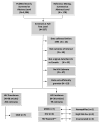Risk of window period HIV infection in high infectious risk donors: systematic review and meta-analysis
- PMID: 21366859
- PMCID: PMC3110509
- DOI: 10.1111/j.1600-6143.2010.03329.x
Risk of window period HIV infection in high infectious risk donors: systematic review and meta-analysis
Abstract
The OPTN defines high risk donors (HRDs), colloquially known as 'CDC high risk donors', as those thought to carry an increased risk of HIV window period (WP) infection prior to serologic detectability. However, the true risk of such infection remains unknown. To quantify the risk of WP infection in each HRD behavior category, we performed a systematic review and meta-analysis of studies of HIV prevalence and incidence. Of 3476 abstracts reviewed, 27 eligible studies of HIV infection in HRD populations were identified. Pooled HIV incidence estimates were calculated for each category of HRD behavior and used to calculate the risk of WP HIV infection. Risks ranged from 0.09-12.1 per 10 000 donors based on WP for ELISA and 0.04-4.9 based on nucleic acid testing (NAT), with NAT reducing WP risk by over 50% in each category. Injection drug users had the greatest risk of WP infection (4.9 per 10 000 donors by NAT WP), followed by men who have sex with men (4.2:10 000), commercial sex workers (2.7:10 000), incarcerated donors (0.9:10 000), donors exposed to HIV through blood (0.6:10 000), donors engaging in high-risk sex (0.3:10 000) and hemophiliacs (0.035:10 000). These estimates can help inform patient and provider decision making regarding HRDs.
©2010 The Authors Journal compilation©2010 The American Society of Transplantation and the American Society of Transplant Surgeons.
Conflict of interest statement
DISCLOSURE
The authors have no conflict of interest to disclose. This study was not funded in any way by a commercial organization.
Figures


Comment in
-
Feces in our food, viruses in our organs: donor surveillance, organ transplantation and the risk for disease transmission.Am J Transplant. 2011 Jun;11(6):1115-6. doi: 10.1111/j.1600-6143.2011.03600.x. Am J Transplant. 2011. PMID: 21645246 No abstract available.
-
Re: Risk of window period HIV infection in high infectious risk donors: systematic review and meta-analysis.J Urol. 2011 Dec;186(6):2339. doi: 10.1016/j.juro.2011.08.050. Epub 2011 Oct 26. J Urol. 2011. PMID: 22078613 No abstract available.
References
-
- Minimum Procurement Standards for an Organ Procurment Organization. 2008. [cited 2008 September 12]; Available from: http://www.unos.org/PoliciesandBylaws2/policies/pdfs/policy_2.pdf.
-
- Ahn J, Cohen SM. Transmission of human immunodeficiency virus and hepatitis C virus through liver transplantation. Liver Transpl. 2008;14(11):1603–1608. - PubMed
-
- Hardy WD., Jr General principles of retrovirus immunodetection tests. J Am Vet Med Assoc. 1991;199(10):1282–1287. - PubMed
-
- Simonds RJ. HIV transmission by organ and tissue transplantation. AIDS. 1993;7 (Suppl 2):S35–38. - PubMed
-
- Singer AL, Kucirka LM, Namuyinga RHC, Subramanian AK, Segev DL. The high risk donor: viral infections in solid organ transplantation. Current Opinion in Organ Transplantation. 2008;13:400–404. - PubMed
Publication types
MeSH terms
Grants and funding
LinkOut - more resources
Full Text Sources
Medical

